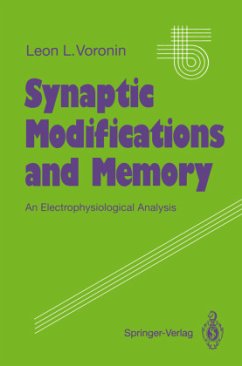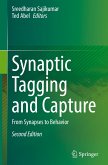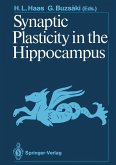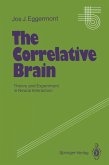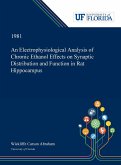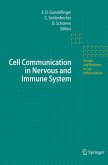- Broschiertes Buch
- Merkliste
- Auf die Merkliste
- Bewerten Bewerten
- Teilen
- Produkt teilen
- Produkterinnerung
- Produkterinnerung
The "neurosciences" is now a common 'term to describe several branches of the biology related to studies of the nervous system. In fact, this term also character izes a multidisciplinary approach to studies of probably the most complicated system of the most complicated living organisms. Investigation of the central ner vous system (CNS) is the most quickly developing branch of the neurosciences. According to Konorski's definition, the CNS "is endowed with two principal properties which are referred to as reactivity and plasticity. Reactivity of the sys tem is its capacity to be activated by…mehr
Andere Kunden interessierten sich auch für
![Synaptic Tagging and Capture Synaptic Tagging and Capture]() Synaptic Tagging and Capture149,99 €
Synaptic Tagging and Capture149,99 €![Synaptic Plasticity in the Hippocampus Synaptic Plasticity in the Hippocampus]() Synaptic Plasticity in the Hippocampus75,99 €
Synaptic Plasticity in the Hippocampus75,99 €![The Correlative Brain The Correlative Brain]() Jos J. EggermontThe Correlative Brain77,99 €
Jos J. EggermontThe Correlative Brain77,99 €![An Electrophysiological Analysis of Chronic Ethanol Effects on Synaptic Distribution and Function in Rat Hippocampus An Electrophysiological Analysis of Chronic Ethanol Effects on Synaptic Distribution and Function in Rat Hippocampus]() Wickliffe AbrahamAn Electrophysiological Analysis of Chronic Ethanol Effects on Synaptic Distribution and Function in Rat Hippocampus88,99 €
Wickliffe AbrahamAn Electrophysiological Analysis of Chronic Ethanol Effects on Synaptic Distribution and Function in Rat Hippocampus88,99 €![The Hippocampus The Hippocampus]() The Hippocampus39,99 €
The Hippocampus39,99 €![Cell Communication in Nervous and Immune System Cell Communication in Nervous and Immune System]() Eckart D. Gundelfinger / Constanze Seidenbecher / Burkhart SchravenCell Communication in Nervous and Immune System149,99 €
Eckart D. Gundelfinger / Constanze Seidenbecher / Burkhart SchravenCell Communication in Nervous and Immune System149,99 €![Synaptic Plasticity and the Mechanism of Alzheimer's Disease Synaptic Plasticity and the Mechanism of Alzheimer's Disease]() Synaptic Plasticity and the Mechanism of Alzheimer's Disease112,99 €
Synaptic Plasticity and the Mechanism of Alzheimer's Disease112,99 €-
-
-
The "neurosciences" is now a common 'term to describe several branches of the biology related to studies of the nervous system. In fact, this term also character izes a multidisciplinary approach to studies of probably the most complicated system of the most complicated living organisms. Investigation of the central ner vous system (CNS) is the most quickly developing branch of the neurosciences. According to Konorski's definition, the CNS "is endowed with two principal properties which are referred to as reactivity and plasticity. Reactivity of the sys tem is its capacity to be activated by stimulation of receptive organs; plasticity is the capacity to change its reactive properties as the result of successive activa tions" ([520], p. 7). According to Kostyuk [535], plastic reorganizations include "any changes in the efficacy or direction of neuronal connectivity which exceed in their duration usual synaptic and spike events" ([535], p. 25). Neuronal plasticity underlies adaptive modifications of various complexities both in normal CNS, e. g. its development, formation of memory traces and condi tioned responses (CRs) , as well as in brain pathology, e. g. reorganization and compensation of damaged nervous functions. Clarification of plasticity mecha nisms is of great cognitive importance and might be of practical value in the treatment of mental and especially memory disorders.
Produktdetails
- Produktdetails
- Studies of Brain Function .19
- Verlag: Springer / Springer Berlin Heidelberg / Springer, Berlin
- Artikelnr. des Verlages: 978-3-642-47619-8
- Softcover reprint of the original 1st edition 1993
- Seitenzahl: 320
- Erscheinungstermin: 9. April 2012
- Englisch
- Abmessung: 235mm x 155mm x 18mm
- Gewicht: 487g
- ISBN-13: 9783642476198
- ISBN-10: 3642476198
- Artikelnr.: 37479827
- Herstellerkennzeichnung Die Herstellerinformationen sind derzeit nicht verfügbar.
- Studies of Brain Function .19
- Verlag: Springer / Springer Berlin Heidelberg / Springer, Berlin
- Artikelnr. des Verlages: 978-3-642-47619-8
- Softcover reprint of the original 1st edition 1993
- Seitenzahl: 320
- Erscheinungstermin: 9. April 2012
- Englisch
- Abmessung: 235mm x 155mm x 18mm
- Gewicht: 487g
- ISBN-13: 9783642476198
- ISBN-10: 3642476198
- Artikelnr.: 37479827
- Herstellerkennzeichnung Die Herstellerinformationen sind derzeit nicht verfügbar.
1 Hippocampal Long-Term Potentiation and Its Characteristics.- 1.1 Brief Overview of the Structure of the Hippocampus.- 1.2 Electrical Responses of the Hippocampus.- 1.3 Initial Experiments on Long-Term Potentiation.- 1.4 Working Hypothesis and Early Results.- 1.5 Methods.- 1.6 Long-Term Potentiation of Field Potentials in the CA3 and CAI Regions.- 1.7 Low-Frequency Depression and Self-Restoration of the Potentiated Response.- 1.8 Specificity of Long-Term Potentiation for the Tetanized Input.- 1.9 Involvement of Reinforcing Systems During Tetanization.- 1.10 Discussion.- 1.11 Summary.- 2 Unitary and Minimal Postsynaptic Potentials (Literature Review).- 2.1 Introduction.- 2.2 Methods Related to Unitary and Minimal PSP Recording.- 2.2.1 Intracellular Stimulation of the Afferent Unit.- 2.2.2 Macrostimulation of Afferent Fibres.- 2.2.3 Intracerebral Microstimulation.- 2.2.4 Recording of "Minimal" PSPs.- 2.2.5 Additional Procedures for the Detection of Single UPSPs.- 2.2.6 Measurements of UPSPs and MPSPs Amplitudes and PSCs.- 2.2.7 Mono- and Polysynaptic UPSPs.- 2.3 Unitary Field Potentials - "EEG Quanta".- 2.4 Applications of Unitary and Minimal PSP Recordings.- 2.4.1 Organization of Neuronal Connections.- 2.4.2 Electrical and Chemical Synapses in the CNS.- 2.4.3 Spatial Organization of Synapses on the Somadendritic Membrane.- 2.5 Studies of Synaptic Plasticity in the CNS.- 2.5.1 Introductory Remarks.- 2.5.2 Habituation and Sensitization in Invertebrate CNSs.- 2.5.3 Conditioning Mechanisms in the Aplysia CNS.- 2.5.4 LFD in the Vertebrate CNS.- 2.6 Conclusions.- 2.7 Summary.- 3 "Minimal" Field Potentials of the Hippocampus and Their Post-Tetanic Changes.- 3.1 Introduction.- 3.2 Methods.- 3.3 Field Potentials Correlated with Neuronal Discharges from theContralateral Hippocampus.- 3.4 Field Activity After Spikes of the Schaffer Collaterals.- 3.5 Minimal Field Potentials.- 3.6 Post-Tetanic Changes of Minimal FPs.- 3.7 Discussion.- 3.8 Summary.- 4 Excitatory Postsynaptic Potentials of Hippocampal Neurones and Their Low-Frequency Depression.- 4.1 Introduction.- 4.2 Methods.- 4.3 Responses to Single Stimuli.- 4.4 Responses to Paired Stimuli of Different Amplitudes.- 4.5 Changes of EPSPs During Low-Frequency Stimulation.- 4.6 Changes of IPSPs During Low-Frequency Stimulation.- 4.7 Discussion.- 4.8 Summary.- 5 Responses of Hippocampal Neurones During Long-Term Potentiation.- 5.1 Introduction.- 5.2 Methods.- 5.3 General Description of Neuronal Responses.- 5.4 Short-Term Post-Tetanic Changes.- 5.5 Long-Term Changes in Spike Responses after Tetanization.- 5.6 Post-Tetanic Changes of Postsynaptic Potentials.- 5.7 Post-Tetanic Changes in Excitability and Resting Membrane Potential.- 5.8 Discussion.- 5.9 Summary.- 6 Changes in Acetylcholine Sensitivity During Long-Term Potentiation.- 6.1 Introduction.- 6.2 Effects of Acetylcholine Iontophoresis on Cellular and Field Responses.- 6.3 Changes in ACh Sensitivity During LTP.- 6.4 Discussion.- 6.5 Summary.- 7 Quantal Analysis of Postsynaptic Potentials (Literature Review).- 7.1 Introduction.- 7.2 Principles of the Quantum Hypothesis.- 7.3 Methods of Determination of the Mean Quantal Content.- 7.3.1 Direct Counting of Quantal Contents of Single PSPs.- 7.3.2 The Method of "Miniatures".- 7.3.3 Histogram Method.- 7.3.4 Method of Failures.- 7.3.5 Method of the Coefficient of Variation.- 7.3.6 Analysis of Dispersions.- 7.3.7 Deconvolution Technique.- 7.3.8 Other Methods.- 7.4 Corrections for the Methods of Estimating m.- 7.4.1 Non-Linear Summation.- 7.4.2 Control of Steady State.- 7.4.3"Non-Specific" Activity.- 7.4.4 Multicomponent Miniature PSPs.- 7.4.5 Additional Remarks.- 7.5 Poisson and Binomial Distributions of PSP Amplitudes.- 7.6 Methods of Estimating Binomial Parameter p.- 7.6.1 Variance of Quantal Distribution.- 7.6.2 Variances of Amplitudes of PSPs and mPSPs.- 7.6.3 Division of Amplitude Histogram According to µ.- 7.6.4 Automatic Computation when v Is Known.- 7.6.5 Automatic Analysis of Amplitude Distributions.- 7.6.6 Combination of Variance and Failures Methods.- 7.6.7 Other Methods.- 7.7 Additional Explanations to Methods of Computing Quantal Parameters.- 7.7.1 Non-Stationarity and Non-Uniformity.- 7.7.2 Models with Non-Uniform p.- 7.7.3 Other Modifications.- 7.8 Basic Quantal Parameters for Various Junctions.- 7.8.1 Neuromuscular Junctions and Autonomic Ganglia.- 7.8.2 Invertebrate CNS.- 7.8.3 Spinal Cord.- 7.8.4 Cerebrum.- 7.8.5 Hippocampus.- 7.9 Binomial Parameters n and p for Various Junctions.- 7.9.1 Neuromuscular Junctions and Autonomic Ganglia.- 7.9.2 Invertebrate CNS.- 7.9.3 Spinal Cord.- 7.9.4 Cerebrum.- 7.10 Quantal Analysis of Synaptic Plasticity.- 7.10.1 Various Applications of Quantal Analysis.- 7.10.2 Frequency Facilitation (FF).- 7.10.3 Frequency Depression (FD).- 7.10.4 Post-Tetanic Potentiation (PTP) and Heterosynaptic Facilitation (HSF).- 7.10.5 Long-Term Facilitation (LTF).- 7.11 Conclusions.- 7.12 Summary.- 8 Application of Quantal Analysis to Central Synapses.- 8.1 Introduction.- 8.2 Methods.- 8.3 Consideration of Known Methods of Determination of Quantal Parameters.- 8.4 The Histogram Method.- 8.5 Method Based on the Ratio of the Mean to Maximal Amplitude.- 8.6 Quantal Parameters of Unitary EPSPs of Snail CNS.- 8.7 Theoretical Distributions of PSP Amplitudes.- 8.8 Discussion.- 8.9 Summary.- 9 Models ofTransmitter Depletion and Their Application to Analysis of Synaptic Plasticity (Literature Review).- 9.1 Introduction.- 9.2 Basic Model Parameters and Recording Conditions.- 9.3 Model of Transmitter Depletion Without Mobilization.- 9.3.1 Method of Paired Stimulation.- 9.3.2 Method of Amplitude Dependence on Serial Stimulus Number During Frequency Stimulation.- 9.3.3 Method of Relationship Between Amplitude and Sum of Amplitudes of Previous Responses.- 9.4 Model of Transmitter Depletion with Mobilization.- 9.4.1 Restoration after Stimulation Method of Paired Stimulation.- 9.4.2 Frequency Stimulation. "Continuous" Model.- 9.4.3 Approximate Estimates of Parameters of the Continuous Model.- 9.4.4 Frequency Stimulation. "Discrete" Model.- 9.5 Modifications of the Depletion Model for Variable F.- 9.5.1 Model of "Partial Depletion".- 9.5.2 "Partial Depletion" with Paired Stimulation.- 9.6 Transmitter Mobilization and Parameters of the Store Pool.- 9.6.1 Relationship Between Mobilization and Stimulus Frequency.- 9.6.2 Dependence of Mobilization on Time.- 9.6.3 Total Transmitter Store.- 9.7 Depletion Model in Studies of Synaptic Plasticity.- 9.7.1 Applications of the Depletion Model and Simple Synaptic Plasticities.- 9.7.2 Frequency Depression and Postactivation Depression.- 9.7.3 Postactivation Facilitation.- 9.7.4 Frequency Facilitation.- 9.7.5 Post-Tetanic Potentiation.- 9.8 Conclusion.- 9.9 Summary.- 10 Parameters of Transmitter Depletion Model for Snail Central Synapses and Comparison of Depletion and Quantal Models.- 10.1 Introduction.- 10.2 Discrete Model of "Partial" Transmitter Depletion.- 10.3 Discrete Model with Arbitrary Changes in F.- 10.4 EPSP Changes During Stimulation.- 10.5 Calculation of Parameters by Basic Methods of the Depletion Model.-10.6 Calculation of Parameters by Method 10.3.- 10.7 Comparison of Parameters of Depletion and Quantal Models.- 10.8 Discussion.- 10.9 Summary.- 11 Quantal Analysis of Short-Term Plasticities at Central Synapses.- 11.1 Introduction.- 11.2 Paired-Pulse Facilitation of Hippocampal Responses.- 11.3 Low-Frequency Depression of Hippocampal Responses.- 11.4 Low-Frequency Depression at Snail Central Synapses.- 11.5 Paired-Pulse Facilitation in Hippocampal Slices.- 11.6 Discussion.- 11.7 Summary.- 12 Quantal Analysis of Hippocampal Long-Term Potentiation in Vivo.- 12.1 Introduction.- 12.2 Methods.- 12.3 Unitary Postsynaptic Potentials of Hippocampal Neurones.- 12.4 Post-Tetanic Changes in Postsynaptic Potentials Evoked by Microstimulation.- 12.5 Statistical Analysis of Minimal EPSPs Evoked by Microstimulation.- 12.6 Changes in Quantal Parameters After Tetanization.- 12.7 Discussion.- 12.8 Summary.- 13 Quantal Analysis of Minimal Postsynaptic Potentials in Hippocampal Slices: Binomial Model.- 13.1 Introduction.- 13.2 Methods.- 13.3 Results of Computer Simulations.- 13.3.1 Testing Different Methods.- 13.3.2 Testing Methods of p Determination.- 13.3.3 Testing "Objective" Method of Failures Determination.- 13.4 Results of Physiological Experiments.- 13.4.1 General Description.- 13.4.2 Testing EPSP Amplitude Stability.- 13.4.3 Comparison of Parameters Calculated from Different Samples.- 13.4.4 Objective vs. Subjective Method of Failures Determination.- 13.4.5 Comparison of Different Methods.- 13.4.6 Optimization of Noise Standard Deviation.- 13.4.7 Mean Quantal Parameters of Hippocampal Synapses.- 13.5 Discussion.- 13.5.1 Simulation Experiments.- 13.5.2 EPSP Measurements and Noise Reduction.- 13.5.3 Testing Procedures and Sample Sizes.- 13.5.4 Applicability of the QuantumHypothesis and Simple Binomial Model.- 13.5.5 Noise Reduction During EPSP.- 13.5.6 Quantal Parameters of Hippocampal Synapses.- 13.6 Summary.- 14 Binomial Analysis of Long-Term Potentiation of Minimal EPSPs in Hippocampal Slices.- 14.1 Introduction.- 14.2 Methods.- 14.3 Results.- 14.3.1 Long-Term Potentiation of Minimal EPSPs.- 14.3.2 Estimates of Quantal Parameters.- 14.3.3 Post-Tetanic Changes in Mean Quantal Content.- 14.3.4 Post-Tetanic Changes in Quantal Size.- 14.3.5 Post-Tetanic Changes in Binomial Parameters.- 14.3.6 Differential Changes in m and v for Different LTP Magnitudes.- 14.4 Discussion.- 14.5 Summary.- 15 Analysis of Fluctuations of Minimal EPSPs in Vitro: Quantal Model.- 15.1 Introduction.- 15.2 Methods.- 15.3 Results of Simulation Experiments.- 15.4 Results of Physiological Experiments.- 15.5 Discussion.- 15.5.1 Reliability of the Deconvolution Procedure.- 15.5.2 Post-Tetanic Changes in Quantal Parameters.- 15.5.3 Differential Changes in Quantal Parameters at Different LTP Magnitudes.- 15.5.4 Two Types of Synaptic Mechanisms of LTP Maintenance.- 15.6 Summary.- General Conclusions.- References.
1 Hippocampal Long-Term Potentiation and Its Characteristics.- 1.1 Brief Overview of the Structure of the Hippocampus.- 1.2 Electrical Responses of the Hippocampus.- 1.3 Initial Experiments on Long-Term Potentiation.- 1.4 Working Hypothesis and Early Results.- 1.5 Methods.- 1.6 Long-Term Potentiation of Field Potentials in the CA3 and CAI Regions.- 1.7 Low-Frequency Depression and Self-Restoration of the Potentiated Response.- 1.8 Specificity of Long-Term Potentiation for the Tetanized Input.- 1.9 Involvement of Reinforcing Systems During Tetanization.- 1.10 Discussion.- 1.11 Summary.- 2 Unitary and Minimal Postsynaptic Potentials (Literature Review).- 2.1 Introduction.- 2.2 Methods Related to Unitary and Minimal PSP Recording.- 2.2.1 Intracellular Stimulation of the Afferent Unit.- 2.2.2 Macrostimulation of Afferent Fibres.- 2.2.3 Intracerebral Microstimulation.- 2.2.4 Recording of "Minimal" PSPs.- 2.2.5 Additional Procedures for the Detection of Single UPSPs.- 2.2.6 Measurements of UPSPs and MPSPs Amplitudes and PSCs.- 2.2.7 Mono- and Polysynaptic UPSPs.- 2.3 Unitary Field Potentials - "EEG Quanta".- 2.4 Applications of Unitary and Minimal PSP Recordings.- 2.4.1 Organization of Neuronal Connections.- 2.4.2 Electrical and Chemical Synapses in the CNS.- 2.4.3 Spatial Organization of Synapses on the Somadendritic Membrane.- 2.5 Studies of Synaptic Plasticity in the CNS.- 2.5.1 Introductory Remarks.- 2.5.2 Habituation and Sensitization in Invertebrate CNSs.- 2.5.3 Conditioning Mechanisms in the Aplysia CNS.- 2.5.4 LFD in the Vertebrate CNS.- 2.6 Conclusions.- 2.7 Summary.- 3 "Minimal" Field Potentials of the Hippocampus and Their Post-Tetanic Changes.- 3.1 Introduction.- 3.2 Methods.- 3.3 Field Potentials Correlated with Neuronal Discharges from theContralateral Hippocampus.- 3.4 Field Activity After Spikes of the Schaffer Collaterals.- 3.5 Minimal Field Potentials.- 3.6 Post-Tetanic Changes of Minimal FPs.- 3.7 Discussion.- 3.8 Summary.- 4 Excitatory Postsynaptic Potentials of Hippocampal Neurones and Their Low-Frequency Depression.- 4.1 Introduction.- 4.2 Methods.- 4.3 Responses to Single Stimuli.- 4.4 Responses to Paired Stimuli of Different Amplitudes.- 4.5 Changes of EPSPs During Low-Frequency Stimulation.- 4.6 Changes of IPSPs During Low-Frequency Stimulation.- 4.7 Discussion.- 4.8 Summary.- 5 Responses of Hippocampal Neurones During Long-Term Potentiation.- 5.1 Introduction.- 5.2 Methods.- 5.3 General Description of Neuronal Responses.- 5.4 Short-Term Post-Tetanic Changes.- 5.5 Long-Term Changes in Spike Responses after Tetanization.- 5.6 Post-Tetanic Changes of Postsynaptic Potentials.- 5.7 Post-Tetanic Changes in Excitability and Resting Membrane Potential.- 5.8 Discussion.- 5.9 Summary.- 6 Changes in Acetylcholine Sensitivity During Long-Term Potentiation.- 6.1 Introduction.- 6.2 Effects of Acetylcholine Iontophoresis on Cellular and Field Responses.- 6.3 Changes in ACh Sensitivity During LTP.- 6.4 Discussion.- 6.5 Summary.- 7 Quantal Analysis of Postsynaptic Potentials (Literature Review).- 7.1 Introduction.- 7.2 Principles of the Quantum Hypothesis.- 7.3 Methods of Determination of the Mean Quantal Content.- 7.3.1 Direct Counting of Quantal Contents of Single PSPs.- 7.3.2 The Method of "Miniatures".- 7.3.3 Histogram Method.- 7.3.4 Method of Failures.- 7.3.5 Method of the Coefficient of Variation.- 7.3.6 Analysis of Dispersions.- 7.3.7 Deconvolution Technique.- 7.3.8 Other Methods.- 7.4 Corrections for the Methods of Estimating m.- 7.4.1 Non-Linear Summation.- 7.4.2 Control of Steady State.- 7.4.3"Non-Specific" Activity.- 7.4.4 Multicomponent Miniature PSPs.- 7.4.5 Additional Remarks.- 7.5 Poisson and Binomial Distributions of PSP Amplitudes.- 7.6 Methods of Estimating Binomial Parameter p.- 7.6.1 Variance of Quantal Distribution.- 7.6.2 Variances of Amplitudes of PSPs and mPSPs.- 7.6.3 Division of Amplitude Histogram According to µ.- 7.6.4 Automatic Computation when v Is Known.- 7.6.5 Automatic Analysis of Amplitude Distributions.- 7.6.6 Combination of Variance and Failures Methods.- 7.6.7 Other Methods.- 7.7 Additional Explanations to Methods of Computing Quantal Parameters.- 7.7.1 Non-Stationarity and Non-Uniformity.- 7.7.2 Models with Non-Uniform p.- 7.7.3 Other Modifications.- 7.8 Basic Quantal Parameters for Various Junctions.- 7.8.1 Neuromuscular Junctions and Autonomic Ganglia.- 7.8.2 Invertebrate CNS.- 7.8.3 Spinal Cord.- 7.8.4 Cerebrum.- 7.8.5 Hippocampus.- 7.9 Binomial Parameters n and p for Various Junctions.- 7.9.1 Neuromuscular Junctions and Autonomic Ganglia.- 7.9.2 Invertebrate CNS.- 7.9.3 Spinal Cord.- 7.9.4 Cerebrum.- 7.10 Quantal Analysis of Synaptic Plasticity.- 7.10.1 Various Applications of Quantal Analysis.- 7.10.2 Frequency Facilitation (FF).- 7.10.3 Frequency Depression (FD).- 7.10.4 Post-Tetanic Potentiation (PTP) and Heterosynaptic Facilitation (HSF).- 7.10.5 Long-Term Facilitation (LTF).- 7.11 Conclusions.- 7.12 Summary.- 8 Application of Quantal Analysis to Central Synapses.- 8.1 Introduction.- 8.2 Methods.- 8.3 Consideration of Known Methods of Determination of Quantal Parameters.- 8.4 The Histogram Method.- 8.5 Method Based on the Ratio of the Mean to Maximal Amplitude.- 8.6 Quantal Parameters of Unitary EPSPs of Snail CNS.- 8.7 Theoretical Distributions of PSP Amplitudes.- 8.8 Discussion.- 8.9 Summary.- 9 Models ofTransmitter Depletion and Their Application to Analysis of Synaptic Plasticity (Literature Review).- 9.1 Introduction.- 9.2 Basic Model Parameters and Recording Conditions.- 9.3 Model of Transmitter Depletion Without Mobilization.- 9.3.1 Method of Paired Stimulation.- 9.3.2 Method of Amplitude Dependence on Serial Stimulus Number During Frequency Stimulation.- 9.3.3 Method of Relationship Between Amplitude and Sum of Amplitudes of Previous Responses.- 9.4 Model of Transmitter Depletion with Mobilization.- 9.4.1 Restoration after Stimulation Method of Paired Stimulation.- 9.4.2 Frequency Stimulation. "Continuous" Model.- 9.4.3 Approximate Estimates of Parameters of the Continuous Model.- 9.4.4 Frequency Stimulation. "Discrete" Model.- 9.5 Modifications of the Depletion Model for Variable F.- 9.5.1 Model of "Partial Depletion".- 9.5.2 "Partial Depletion" with Paired Stimulation.- 9.6 Transmitter Mobilization and Parameters of the Store Pool.- 9.6.1 Relationship Between Mobilization and Stimulus Frequency.- 9.6.2 Dependence of Mobilization on Time.- 9.6.3 Total Transmitter Store.- 9.7 Depletion Model in Studies of Synaptic Plasticity.- 9.7.1 Applications of the Depletion Model and Simple Synaptic Plasticities.- 9.7.2 Frequency Depression and Postactivation Depression.- 9.7.3 Postactivation Facilitation.- 9.7.4 Frequency Facilitation.- 9.7.5 Post-Tetanic Potentiation.- 9.8 Conclusion.- 9.9 Summary.- 10 Parameters of Transmitter Depletion Model for Snail Central Synapses and Comparison of Depletion and Quantal Models.- 10.1 Introduction.- 10.2 Discrete Model of "Partial" Transmitter Depletion.- 10.3 Discrete Model with Arbitrary Changes in F.- 10.4 EPSP Changes During Stimulation.- 10.5 Calculation of Parameters by Basic Methods of the Depletion Model.-10.6 Calculation of Parameters by Method 10.3.- 10.7 Comparison of Parameters of Depletion and Quantal Models.- 10.8 Discussion.- 10.9 Summary.- 11 Quantal Analysis of Short-Term Plasticities at Central Synapses.- 11.1 Introduction.- 11.2 Paired-Pulse Facilitation of Hippocampal Responses.- 11.3 Low-Frequency Depression of Hippocampal Responses.- 11.4 Low-Frequency Depression at Snail Central Synapses.- 11.5 Paired-Pulse Facilitation in Hippocampal Slices.- 11.6 Discussion.- 11.7 Summary.- 12 Quantal Analysis of Hippocampal Long-Term Potentiation in Vivo.- 12.1 Introduction.- 12.2 Methods.- 12.3 Unitary Postsynaptic Potentials of Hippocampal Neurones.- 12.4 Post-Tetanic Changes in Postsynaptic Potentials Evoked by Microstimulation.- 12.5 Statistical Analysis of Minimal EPSPs Evoked by Microstimulation.- 12.6 Changes in Quantal Parameters After Tetanization.- 12.7 Discussion.- 12.8 Summary.- 13 Quantal Analysis of Minimal Postsynaptic Potentials in Hippocampal Slices: Binomial Model.- 13.1 Introduction.- 13.2 Methods.- 13.3 Results of Computer Simulations.- 13.3.1 Testing Different Methods.- 13.3.2 Testing Methods of p Determination.- 13.3.3 Testing "Objective" Method of Failures Determination.- 13.4 Results of Physiological Experiments.- 13.4.1 General Description.- 13.4.2 Testing EPSP Amplitude Stability.- 13.4.3 Comparison of Parameters Calculated from Different Samples.- 13.4.4 Objective vs. Subjective Method of Failures Determination.- 13.4.5 Comparison of Different Methods.- 13.4.6 Optimization of Noise Standard Deviation.- 13.4.7 Mean Quantal Parameters of Hippocampal Synapses.- 13.5 Discussion.- 13.5.1 Simulation Experiments.- 13.5.2 EPSP Measurements and Noise Reduction.- 13.5.3 Testing Procedures and Sample Sizes.- 13.5.4 Applicability of the QuantumHypothesis and Simple Binomial Model.- 13.5.5 Noise Reduction During EPSP.- 13.5.6 Quantal Parameters of Hippocampal Synapses.- 13.6 Summary.- 14 Binomial Analysis of Long-Term Potentiation of Minimal EPSPs in Hippocampal Slices.- 14.1 Introduction.- 14.2 Methods.- 14.3 Results.- 14.3.1 Long-Term Potentiation of Minimal EPSPs.- 14.3.2 Estimates of Quantal Parameters.- 14.3.3 Post-Tetanic Changes in Mean Quantal Content.- 14.3.4 Post-Tetanic Changes in Quantal Size.- 14.3.5 Post-Tetanic Changes in Binomial Parameters.- 14.3.6 Differential Changes in m and v for Different LTP Magnitudes.- 14.4 Discussion.- 14.5 Summary.- 15 Analysis of Fluctuations of Minimal EPSPs in Vitro: Quantal Model.- 15.1 Introduction.- 15.2 Methods.- 15.3 Results of Simulation Experiments.- 15.4 Results of Physiological Experiments.- 15.5 Discussion.- 15.5.1 Reliability of the Deconvolution Procedure.- 15.5.2 Post-Tetanic Changes in Quantal Parameters.- 15.5.3 Differential Changes in Quantal Parameters at Different LTP Magnitudes.- 15.5.4 Two Types of Synaptic Mechanisms of LTP Maintenance.- 15.6 Summary.- General Conclusions.- References.

